|
|
|
Sort Order |
|
|
|
Items / Page
|
|
|
|
|
|
|
| Srl | Item |
| 1 |
ID:
131857
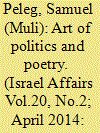

|
|
|
|
|
| Publication |
2014.
|
| Summary/Abstract |
The article demonstrates the potency and volatility of political lyricism by comparing two masters of the trade, the French Jacques Prevert and the Israeli Aryeh Sivan. Although writing in two dissimilar cultures and witnessing disparate political environments, the poetry of Prevert and Sivan is similar in many ways. They are both keen observers of their societies' woes and both are equally critical. Their accounts are s are emphatic and caring and strewn in their passionate, affectionate and brutally honest verses, Prevert and Sivan are the quintessential models for contemporary political poetry. Both poets, despite their disparate cultures and dissimilar local experiences, painstakingly probe and penetrate the political realities around them with velvet nails
|
|
|
|
|
|
|
|
|
|
|
|
|
|
|
|
| 2 |
ID:
131343
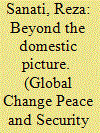

|
|
|
|
|
| Publication |
2014.
|
| Summary/Abstract |
This article examines the geopolitical determinants that have underpinned contemporary Iran-US relations, challenging the established thinking on why this relationship has been characterized by hostility. It is argued that the primacy that has been given to the role of domestic politics in either the US or Iran, as being the main arbiter of this relationship, is incomplete. This relationship is just as much a product of the structural conditions within the Middle East and the wider international system, which created the conditions for the clashing of the core national interests of both these states. However, due to the massive political and social alterations within the Middle East in the past decade, the notion of 'strategic irreconcilability' between both actors is now fundamentally changing. This has given room for a possible recalibration of the Iran-US relationship. Ultimately, it is argued that the synthesis of the domestic, the regional, and geopolitical levels of analysis are needed for a more holistic picture of the past, present, and future of Iran-US ties.
|
|
|
|
|
|
|
|
|
|
|
|
|
|
|
|
| 3 |
ID:
108508
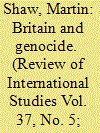

|
|
|
|
|
| Publication |
2011.
|
| Summary/Abstract |
This article (originally given as the Annual War Studies Lecture at King's College, London, on 25 January 2010) challenges the assumption that Britain's relationship to genocide is constituted by its 'vigilance' towards the genocide of others. Through a critical overview of the question of genocide in the historical and contemporary politics of the British state and society, the article suggests their wide-ranging, complex relationships to genocide. Utilising a conception of genocide as multi-method social destruction and applying the interpretative frames of the genocide literature, it argues that the British state and elements of identifiably British populations have been involved directly and indirectly in genocide in a number of different international contexts. These are addressed through five themes: the role of genocide in the origins of the British state; the problem of genocide in the Empire and British settler colonialism; Britain's relationships to twentieth-century European genocide; its role in the genocidal violence of decolonisation; and finally, Britain's role in the genocidal crises of the post-Cold War world. The article examines the questions of national responsibility that this survey raises: while rejecting simple ideas of national responsibility as collective guilt, it nevertheless argues that varying kinds of responsibility for genocide attach to British institutions, leaders and population groups at different points in the history surveyed.
|
|
|
|
|
|
|
|
|
|
|
|
|
|
|
|
| 4 |
ID:
133578
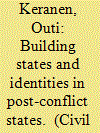

|
|
|
|
|
| Publication |
2014.
|
| Summary/Abstract |
An integral part of state formation processes is identity-building: 'making one out of many' as Walzer puts it. This is also true in terms of contemporary, internationally led statebuilding projects. This dimension of international statebuilding is important, as fundamental questions pertaining to belonging are as important to successful post-conflict process as institutional arrangements; in fact, assumptions about identities and group boundaries guide the technical decisions on institutional and governance structures. The central aim of this paper is to reflect upon identity-construction as a part of post-conflict statebuilding through exploring how historical and more recently invented symbols are deployed to construct a specific sense of belonging. The analysis finds a multiplicity of identity-building projects that advance different visions of community and belonging. The outcome is politicised and contentious visual, everyday landscape that legitimises competing local statebuilding projects (grounded in the distinctions between Bosnian peoples), while undermining peacebuilding and reconciliation. Yet, rather than indicating a primordial antagonisms or incompatible 'liberal' and 'local' norms, the conflicts over symbols (and ultimately, identities) between international and local agents are indicative of wider disagreements over how the Bosnian state ought to be organised and are fuelled by the institutional structures of the country and the weaknesses in the international statebuilding
|
|
|
|
|
|
|
|
|
|
|
|
|
|
|
|
| 5 |
ID:
130607
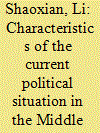

|
|
|
|
|
| Publication |
2014.
|
| Summary/Abstract |
By comparison with the "Arab Spring" that swept through the whole Bregion in 2011 and the political transition evident in many Arab countries in 2012, political development in the Middle East in 2013, to many observers, seemed lost in chaos. Arab countries undergoing political change were plagued by disorder, volatility, and violence. With US. strategic withdrawal from the region imminent, geopolitical dynamics
regrouped. Struggles among regional powers entered a new stage. Four characteristics of the Middle East situation are harbingers for future outcomes: political "ehaos" in the Arab world, "flux and reflux" between moderate and radical lslamists, geopolitical shocks caused by the strategic withdrawal of the U.S. from the region, and continued uncertainty over the Iranian nuclear issue.
|
|
|
|
|
|
|
|
|
|
|
|
|
|
|
|
| 6 |
ID:
132273
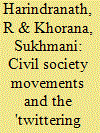

|
|
|
|
|
| Publication |
2014.
|
| Summary/Abstract |
Using Partha Chatterjee's insights on the formation of 'civil society' and how this is distinct from 'political society', this paper theorises the mobilisation of popular support via social media during the so-called 'anti-corruption movement' in India in 2011. It tracks the main themes of the civil society-led movement's Twitter feeds during two crucial phases of fasting by its self-proclaimed Gandhian leader, Anna Hazare. This highlights the mixing of nostalgic pre-independence discourses with new media savvy and provides a means of contextualising what such discursive mobilisation means for contemporary political formations in a post-colonial society such as India. The case study also sheds light on the urban- and middle-class-centred nature of the protest and its preference for media over electoral representation-this is in line with Chatterjee's conceptualisation of a civil society that undermines the authority of the state and excludes the rural and urban poor.
|
|
|
|
|
|
|
|
|
|
|
|
|
|
|
|
| 7 |
ID:
130615
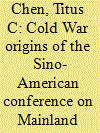

|
|
|
|
|
| Publication |
2014.
|
| Summary/Abstract |
this article adopts a reflexive approach to investigate the history of the Sino-American Conference on mainland China (SACMC), the Cold War precursor of the Taiwan - US Conference on contemporary China (TUSCCC) organized and hosted by the institute of international relations (IIR) of the republic of China , the Cold war origins of the SACMC demonstrate the nation that power and knowledge- the practice of politics and theory of politics are asymmetrically and symbiotically co-constitute.
|
|
|
|
|
|
|
|
|
|
|
|
|
|
|
|
| 8 |
ID:
133612
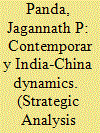

|
|
|
|
|
| Publication |
2014.
|
| Summary/Abstract |
This review essay examines the significance of India-China relations against the background of the current phenomenon of a multipolar world in the light of four recent publications on the subject. Tien-sze Fang's and Jeff M. Smith's works discuss the current facets of India-China relations, while William Antholis's and Carl J. Dahlman's works deal with the character and standing that India and China bring to their regional and global discourse. After reviewing the core of these books, this essay will seek to locate the dialogue and import of India-China relations in two constructive settings: first, the versatility of this relationship in a multipolar world order; second, why this relationship is important to the future of multipolar world politics. In the official idiom, India-China dynamics are not confined to the bilateral ambience. For example, a joint statement issued on the occasion of the visit of Premier Li Keqiang to India (May 20, 2013) records that 'There is enough space in the world for the development of India and China … As the two largest developing countries in the world, the relationship between India and China transcends bilateral scope and has acquired regional, global and strategic significance'.1 This official endorsement comes against the background that the year 2014 is the 60th anniversary of the occasion when the Panchasheel discourse was first enunciated.
|
|
|
|
|
|
|
|
|
|
|
|
|
|
|
|
| 9 |
ID:
128275
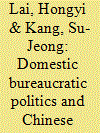

|
|
|
|
|
| Publication |
2014.
|
| Summary/Abstract |
One of the outstanding features of China's domestic politics is the prominence of the bureaucracy in the policy-making process. Arguably, bureaucracy is the next major player in the policy-making process in China after the top leaders. In this article, the three following aspects of the role of bureaucracy in the Chinese foreign policy-making process are examined: (1) the structure of the bureaucracy, especially the main agencies of the bureaucracy involved in foreign policy making; (2) the respective responsibilities of these agencies and their roles in the process; and (3) inter-agency coordination including the resolution of conflict among them. It observes that while the Ministry of Foreign Affairs plays a key role in the process, other ministries and bureaucratic agencies have significant and even growing input in an increasing number of functional areas, such as trade, finance, economy, climate change, soft power and military affairs. In addition, coordination among these agencies has become a key in the policy-making process.
|
|
|
|
|
|
|
|
|
|
|
|
|
|
|
|
| 10 |
ID:
105194
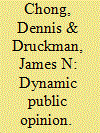

|
|
|
|
|
| Publication |
2010.
|
| Summary/Abstract |
We develop an approach to studying public opinion that accounts for how people process competing messages received over the course of a political campaign or policy debate. Instead of focusing on the fixed impact of a message, we emphasize that a message can have variable effects depending on when it is received within a competitive context and how it is evaluated. We test hypotheses about the effect of information processing using data from two experiments that measure changes in public opinion in response to alternative sequences of information. As in past research, we find that competing messages received at the same time neutralize one another. However, when competing messages are separated by days or weeks, most individuals give disproportionate weight to the most recent communication because previous effects decay over time. There are exceptions, though, as people who engage in deliberate processing of information display attitude stability and give disproportionate weight to previous messages. These results show that people typically form significantly different opinions when they receive competing messages over time than when they receive the same messages simultaneously. We conclude by discussing the implications of our findings for understanding the power of communications in contemporary politics.
|
|
|
|
|
|
|
|
|
|
|
|
|
|
|
|
| 11 |
ID:
129989
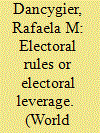

|
|
|
|
|
| Publication |
2014.
|
| Summary/Abstract |
Immigration has fundamentally altered the ethnic and religious makeup of most advanced democracies, but substantial variation is observed in the political representation of immigrant-origin minority groups across countries and cities. Though existing research has highlighted the role of electoral institutions in explaining minority representation, it is often difficult to isolate their effects across contexts. Focusing on Muslims in England and employing a new data set containing over 42,000 candidate-level observations, this article explains Muslim candidate election and selection. To do this, the author makes use of a rule change whereby a subset of localities switched from the use of multimember elections to the use of single-member elections. She finds that these electoral rules have no significant effect on the share of Muslims that gets elected but that they do influence the selection process: in a given election, Muslims are half as likely to be selected when only one seat is up for election as compared with when three seats are in play. Yet parties balance the slate across consecutive single-member elections, leading to similar results across systems. Further, the more undesirable the seat, the more likely it is to have a Muslim on the ticket, but this effect holds only in single-member elections, and it reverses as Muslims gain electoral leverage. Overall electoral leverage proves crucial: the effect of institutions and the potential for institution-based discrimination are conditional on the size and concentration of the local Muslim population and the votes it can deliver at both the election and the selection stages.
|
|
|
|
|
|
|
|
|
|
|
|
|
|
|
|
| 12 |
ID:
131426
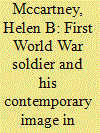

|
|
|
|
|
| Publication |
2014.
|
| Summary/Abstract |
The image of the First World War soldier as a cowed victim, caught in the grip of a meaningless, industrialized war, is one that has become entrenched in the British popular imagination. It was not, however, the image that dominated public discussion of the soldier between 1914 and 1918. This article seeks to examine how the portrayal of the soldier changed during and after the First World War and proposes that the victimized soldier motif has been reinforced today by the coalescence of three trends. The first is the growth of the family history industry that encourages an individualized and empathetic approach to the First World War. The second trend is concerned with an increasing public interest in psychological reactions to war. Since the Vietnam War, there has been a growing expectation that soldiers will be psychologically damaged by wartime experience. This has influenced the public perception of the First World War soldier, affecting, in particular, the discussion surrounding those executed for military crimes during the conflict. Finally, the article argues that long-term changes in British attitudes to the use of force, coupled with the experience of recent conflicts in Iraq and Afghanistan, have also coloured the way in which the First World War is portrayed. A range of interest groups have cast the contemporary British soldier as a victim in recent years and the article argues that the explicit linking of operations in Afghanistan and Iraq with the First World War has reinforced this victim image for each conflict.
|
|
|
|
|
|
|
|
|
|
|
|
|
|
|
|
| 13 |
ID:
130984
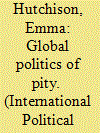

|
|
|
|
|
| Publication |
2014.
|
| Summary/Abstract |
The study of emotion has become a steadily growing field in humanitarian actions. This essay adds to the field through a further empirical examination of the political roles emotions can play. Specifically, the essay questions how emotions were implicated in the construction of transnational solidarity-and the associated humanitarian actions-following an event of pivotal global importance: the Asian tsunami disaster of December 2004. To this end, I focus on the emotional dimensions of dominant media tsunami imagery and examine how emotions helped to produce the humanitarian meanings and ideologies on which the subsequent solidarity and humanitarian actions were based. Analyzing photographs in the New York Times, the essay demonstrates that the dominant tsunami imagery helped to evoke solidarity and garner aid. It did so, at least in part, through mobilizing stereotypical and deeply colonial representations of developing world disaster that are suggestive of a "politics of pity." In this way, the essay contributes both an empirical study of emotions in world politics and an examination of the linkages between emotions and contemporary humanitarianism.
|
|
|
|
|
|
|
|
|
|
|
|
|
|
|
|
| 14 |
ID:
130809
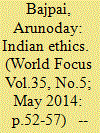

|
|
|
|
|
| Publication |
2014.
|
| Summary/Abstract |
The contemporary global community continues to be in throes of multiple problems accumulated in the course of growth and development of human civilization. The problems of violence within and among nations: rising terrorism and organized crimes in different parts of the globe; increasing poverty and hunger: threatening dimensions of food and energy crises and to cap it all pending catastrophe of climate change and other forms of environmental degradation. it is not that the global community- and nations collectively or individually are not aware of these challenges or they have failed to corrective actions. We are more aware of these problems than any time in the history of mankind. Also. we have put in place various strategies. policies and mechanisms to manage. and solve these challenges. Even global community has suddenly woken up to the call for switching over to the alternative vision of sustainable development. However. the alternative sustainable development strategy seems faltering amidst of unsustainable ideas and practices inspired by materialistic progress and over emphasis on sel?sh interests of nations and individuals alike. The moot question is how the prevailing development paradigms fashioned and refashioned to suits the needs of evolving globalized economy is capable of facing these challenges? What are its ethical foundations? What alternative ethical framework or vision we can evolve? And ?nally, how the Indian ethical framework is relevant for this alternative vision?
|
|
|
|
|
|
|
|
|
|
|
|
|
|
|
|
| 15 |
ID:
131418
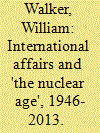

|
|
|
|
|
| Publication |
2014.
|
| Summary/Abstract |
The article reflects on the distinguished record of publication, in around 130 articles over nearly seventy years, on nuclear politics in International Affairs. Although constituting a small drop in the torrent of writings on nuclear matters since 1945, it can fairly be regarded as the most significant contribution to nuclear discourse by any journal outside the United States. The articles published in International Affairs have covered a wide range of issues including nuclear deterrence and strategy, arms control, non-proliferation and disarmament, and the policies-and drivers of policy-of countries, in particular the UK and US. Authors have included P. M. S. Blackett, Wyn Bowen, Alastair Buchan, Hedley Bull, Pierre Hassner, Michael Howard, Rebecca Johnson, Michael MccGwire, Michael Quinlan, Nick Ritchie, John Simpson and David Yost. The discussion concludes with Ian Smart's article of 1975 in which he contemplates the nature of the 'nuclear age' and its persistence or passing, and comments on governments' 'fatuous' attachment of prestige value to nuclear weapons.
|
|
|
|
|
|
|
|
|
|
|
|
|
|
|
|
| 16 |
ID:
163287
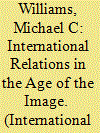

|
|
|
|
|
| Summary/Abstract |
Images pervade contemporary politics. Across the globe, people receive more and more of their information and impressions about politics through media outlets saturated with images, while political leaders show increasing skill in melding popular culture and political power. Understanding the aesthetic dimensions of world politics is thus of paramount importance. This article seeks to deepen our understanding of the historical and political relationship between images and international theory. Contrary to the predominant view, it argues that, far from being absent from international relations (IR), aesthetics concerns were at the heart of the intellectual politics in which the postwar study of international relations developed. The article shows that suspicion toward aesthetics in IR is not simply the result of ignorance about emotions or images in politics, nor of methodological myopia. Instead its roots are political and lie in the powerful political constellation of Cold War liberalism, social science, and the foreign policy strategies and political struggles of the Cold War. This history has largely disappeared from the self-understanding of the field, but its recovery is essential in appreciating the place of aesthetics in international relations theory and addressing the challenges posed by aesthetics in contemporary world politics.
|
|
|
|
|
|
|
|
|
|
|
|
|
|
|
|
| 17 |
ID:
133296
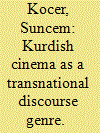

|
|
|
|
|
| Publication |
2014.
|
| Summary/Abstract |
Within the last few years, "Kurdish cinema" has emerged as a unique discursive subject in Turkey. Subsequent to and in line with efforts to unify Kurdish cultural production in diaspora, Kurdish intellectuals have endeavored to define and frame the substance of Kurdish cinema as an orienting framework for the production and reception of films by and about Kurds. In this article, my argument is threefold. First, Kurdish cinema has emerged as a national cinema in transnational space. Second, like all media texts, Kurdish films are nationalized in discourse. Third, the communicative strategies used to nationalize Kurdish cinema must be viewed both in the context of the historical forces of Turkish nationalism and against a backdrop of contemporary politics in Turkey, specifically the Turkish government's discourses and policies related to the Kurds. The empirical data for this article derive from ethnographic research in Turkey and Europe conducted between 2009 and 2012.
|
|
|
|
|
|
|
|
|
|
|
|
|
|
|
|
| 18 |
ID:
131760
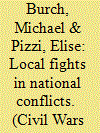

|
|
|
|
|
| Publication |
2014.
|
| Summary/Abstract |
How do rebel groups determine their targets during intrastate conflict? We build upon two competing theories in conflict studies that emphasize either the social or economic determinants of violence during war and use geographic information systems (GIS) analysis to explore these competing theories. To do this, we utilize a subnational analysis of the most likely case of the Democratic Republic of the Congo to understand whether ethnicity or natural resources motivates the location of conflict events. Accounting for geography, we find that economic endowments in the form of natural resources are highly related with the number of violent attacks, while the presence of competing ethnic groups does not offer much help in understanding the location of conflict events.
|
|
|
|
|
|
|
|
|
|
|
|
|
|
|
|
| 19 |
ID:
134037
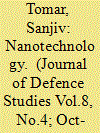

|
|
|
|
|
| Publication |
2014.
|
| Summary/Abstract |
The last decade has witnessed unprecedented developments in thediscovery of novel materials and their radically different propertiesat nanoscales. Global efforts in research and development (R&D)in nanotechnology are being undertaken by many countries dueto far-reaching benefits encompassing the entire arena of scienceand technology. The field of defence is likely to profit immensely bynanotechnology-enabled applications. The impact of these applicationswill have a direct bearing on soldier in the battlefield in terms ofenhanced protection, lethality, manoeuvrability, communication, healthmonitoring, and surveillance. This article dwells upon the current globalscenario of nanotechnology and how a 'soldier as a system' can beconceived through integration of nanotechnology-enabled applications.
|
|
|
|
|
|
|
|
|
|
|
|
|
|
|
|
| 20 |
ID:
140189
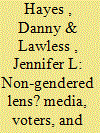

|
|
|
|
|
| Summary/Abstract |
Much research in the study of U.S. politics has argued that female candidates for elected office are treated differently—and often worse—than male candidates in the press and by the public. Although these patterns do not doom women to electoral failure, they raise a formidable series of obstacles that often complicate women’s path to elective office, slowing the move toward gender parity in representation. Broad changes to the American political landscape, as well as methodological limitations of previous work, however, suggest the need for an updated assessment. We rely on a detailed content analysis of local newspaper coverage from nearly 350 U.S. House districts and nationally representative survey data from the 2010 midterms to provide a comprehensive evaluation of whether women experience a more hostile campaign environment than do men. We find that candidate sex does not affect journalists’ coverage of, or voters’ attitudes toward, the women and men running for office in their districts. Rather, reporters’ portrayals and citizens’ assessments of candidates stem primarily from partisanship, ideology, and incumbency, not the sex of the candidate. Although our results differ from much of the existing literature, we regard them as a valuable point of departure for answering pressing questions about gender and representation in contemporary politics, both in an American and comparative context.
|
|
|
|
|
|
|
|
|
|
|
|
|
|
|
|
|
|
|
|
|